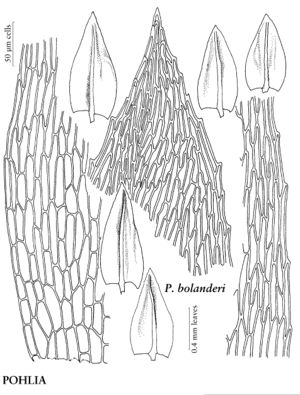Pohlia bolanderi
in H. G. A. Engler and K. Prantl, Nat. Pflanzenfam. 218[I,3]: 548. 1903.
Plants small to medium-sized, green or sometimes pale whitish, somewhat shiny. Stems 0.3–1.5 cm. Leaves erect to ± spreading, lanceolate to narrowly ovate-lanceolate, 0.8–1.6 mm; base not or scarcely decurrent; margins serrulate to serrate in distal 1/3; costa subpercurrent or percurrent; distal medial laminal cells linear-rhomboidal, 55–100 µm, walls thin. Specialized asexual reproduction absent. Sexual condition dioicous; perigonial leaves ovate; perichaetial leaves slightly differentiated, ovate-lanceolate. Seta stramineous to orange-brown. Capsule inclined 35–90°, stramineous to orange-brown, narrowly cylindric, neck 1/2–1 time urn length; exothecial cells elongate-rectangular, walls straight; stomata superficial; annulus present; operculum conic; exostome teeth yellow to yellow-brown, acute-triangular; endostome hyaline, basal membrane 1/4–1/2 exostome length, segments tapered apically, narrowly keeled, narrowly to not perforate, cilia absent to rudimentary. Spores 16–26 µm, distinctly roughened.
Phenology: Capsules mature summer (Jun–Aug).
Habitat: Dry alpine soil, soil-filled rock crevices
Elevation: low to high elevations
Distribution

B.C., Alaska, Calif., Colo., Nev., N.Mex., Oreg., Utah, Wash., Wyo., Europe.
Discussion
Pohlia bolanderi has glossy to whitish leaves. Glossy forms might be confused with P. longicolla, but P. bolanderi can be distinguished by its smaller size and dioicous inflorescences. The leaves of P. bolanderi are smaller and relatively broader than those of P. longicolla. Variety seriata is characterized by whitish, ranked leaves; it is not recognized here because of intermediate plants from western North America, although in their best development these plants are very distinctive. Plants of this variant might be confused with Conostomum tetragonum (Bartramiaceae).
Selected References
None.
